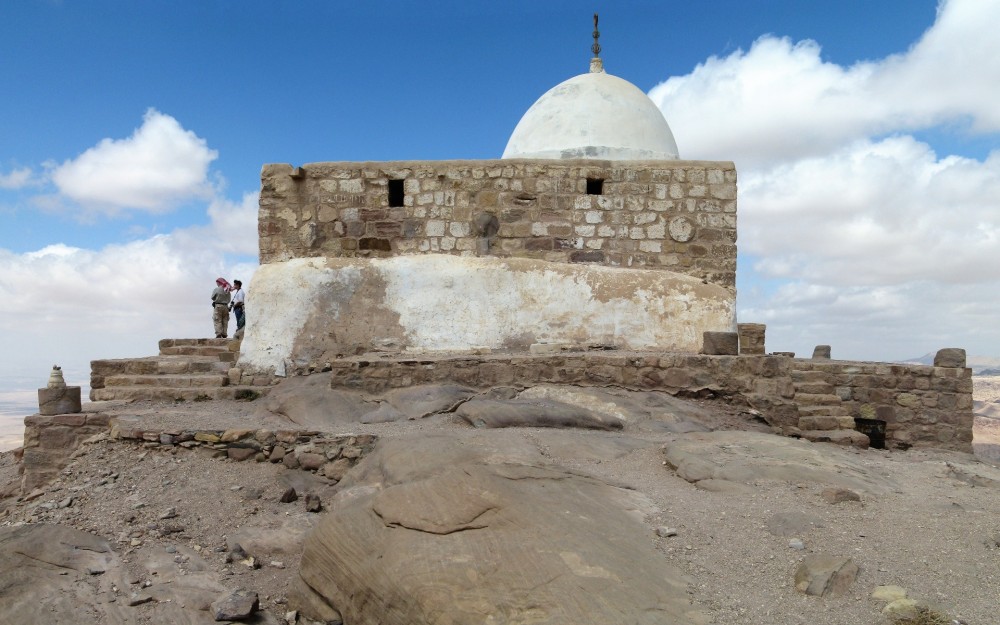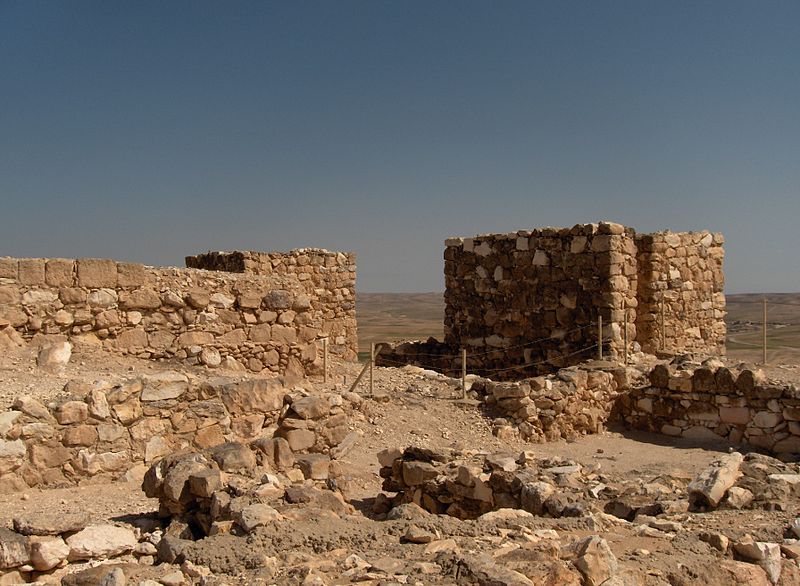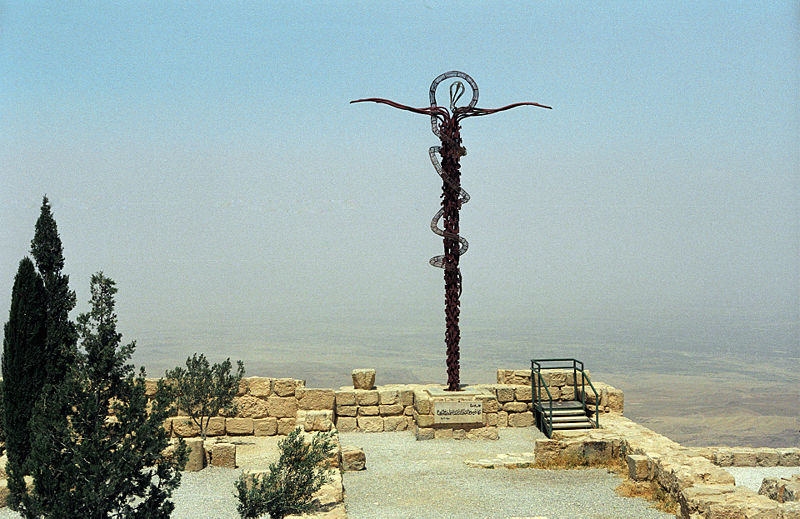Num 20:14-21 It's now nearly forty years since Moses led the Israelites out of Egypt towards the 'promised land' of Canaan. As the Edomites were descended from Jacob’s brother Esau (see Genesis 32:3 & Deuteronomy 2:8), Moses sends messengers to the King of Edom requesting safe passage through his territory lying to the south east of Canaan.
But the king sends a large and powerful army against the Israelites and will not allow them to pass through Edom. The only way into the ‘promised land’ of Canaan is to be by force of arms.
Num 20:22-29 The Israelites leave Kadesh in c.1407BC and travel north towards Canaan, skirting to the west of Edom (see 6 on Map 45). At Mt Hor, Aaron dies and is succeeded as Chief Priest (see Exodus 28:1) by his son Eleazor.
Mount Hor
Although it is not on the route between Kadesh and Atharim as described in the Book of Numbers, Mount Hor – where Aaron died – is traditionally identified as Jabal Harun – Mount Aaron – 3 miles / 5 km west of Petra in Jordan. This remote site – the highest point in the area at 1350 metres – can be reached by walking along the path through the Wadi Musa (‘Moses Valley’) via the gorge (The Siq) leading to Petra.

Shrine on the summit of Jabal Harun (Mt Aaron) near Petra (Joneikifi)
Today, a small 14th century Islamic mosque with a white dome sits on the summit of Jabal Harun while, nearby, visitors can explore the excavated remains of the 5th – 7th century Byzantine monastery and Church of St Aaron.
Num 21:1-3 As the Israelites come closer to Canaan, the Canaanite King of Arad attacks them in the northern Negev Desert on the road to Atharim and many Israelites are captured and led in captivity north to Arad (see 6 on Map 45).
A detachment of crack Israelite commandos mounts a daring raid deep into Canaanite territory to the north. After a fierce struggle, the King of Arad is eventually defeated at Hormah (meaning ‘destruction’), near Arad, but the Israelites decide that it would be more prudent to retreat southwards and to attack Canaan from the east.
Arad
Arad was a powerful and long-established Canaanite city-state when the Israelites made their first attempt to march into the ‘promised land’ in c.1407BC. Located just north of the Negev Desert some 28 miles / 45 km east of Beersheba and 15 miles / 25 km west of the Dead Sea, it formed the most southerly city of Canaan and a fierce obstacle to any new settlers. Alerted by his border guards, the King of Arad marched south and captured many Israelites before they got anywhere near the city. The Israelites later mounted a successful counter-attack, but were unable to take the city, so they retreated south in order to attack Canaan from the east.

The reconstructed western gate at Tel Arad (Acer 11)
Visitors to Tel Arad, about 6 miles / 9 km west of the modern city of Arad, can see extensive remains of the Canaanite (lower) city, including the city wall, the reconstructed Western Gate and partially reconstructed houses. After the conquest of Canaan under Joshua in c.1406BC, Arad became the southernmost city of Israel. The prominent remains of the Israelite fortress on the summit of the Citadel date from the time of King Solomon. An Israelite temple with a small ‘Holy of Holies’ and incense altars for the followers of Yahweh and Asherah demonstrate how the worship of the one true God became compromised during the Divided Monarchy. The temple at Arad was abandoned during the religious reforms ushered in by King Josiah (see 2 Kings 23:4-8).
Arad was largely destroyed by the Babylonians prior to the fall of Jerusalem in 587BC, but it remained inhabited until the Roman Emperor Hadrian expelled its Jewish population in 135AD.
Num 21:4-5 The Israelites turn south from Mt Hor and retrace their steps towards Ezion-geber and the Red Sea in order to skirt round to the south and east of Edom (see 7 on Map 45).
Num 21:6-9 Many are bitten by poisonous snakes in the southern Negev Desert. The LORD commands Moses to make a bronze snake on a pole so that those who are bitten may look up at it and be healed. The bronze snake is revered and later called the 'Nehushtan' (2 Kings 18:4).

Bronze Serpent monument on Mt Nebo (Jerzy Strzelecki)
This symbol of a snake twined around a pole is used today as an internationally recognised sign denoting the availability of medical assistance. The brazen serpent monument on the summit of Mt Nebo commemorates this incident.
